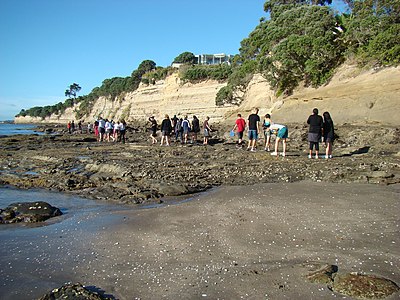Field trip
hideThis article has multiple issues. Please help or discuss these issues on the talk page. (Learn how and when to remove these template messages)
|

A field trip or excursion is a journey by a group of people to a place away from their normal environment.
When done for students, as it happens in several school systems, it is also known as school trip in the UK, Australia and New Zealand, School Tour in Ireland.
The purpose of the trip is usually observation for education, non-experimental research or to provide students with experiences outside their everyday activities, such as going camping with teachers and their classmates. The aim of this research is to observe the subject in its natural state and possibly collect samples. It is seen that more-advantaged children may have already experienced cultural institutions outside of school, and field trips provide a common ground with more-advantaged and less-advantaged children to have some of the same cultural experiences in the arts.[1]
Field trips are most often done in 3 steps: preparation, activities and follow-up activity. Preparation applies to both the student and the teacher. Teachers often take the time to learn about the destination and the subject before the trip. Activities that happen on the field trips often include: lectures, tours, worksheets, videos and demonstrations. Follow-up activities are generally discussions that occur in the classroom once the field trip is completed.[2]
In Western culture people first come across this method during school years when classes are taken on school trips to visit a geological or geographical feature of the landscape, for example. Much of the early research into the natural sciences was of this form. Charles Darwin is an important example of someone who has contributed to science through the use of field trips.[citation needed]
Popular field trip sites include zoos, nature centers, such as fire stations and hospitals, government agencies, local businesses, amusement parks, science museums, and factories. Field trips provide alternative educational opportunities for children and can benefit the community if they include some type of community service. Field trips also provide students the opportunity to take a break from their normal routine and experience more hands on learning. Places like zoos and nature centers often have an interactive displays that allow children to touch plants or animals.[3]
Today, culturally enriching field trips are in decline. Museums across the United States report a steep drop in school tours. For example, the Field Museum in Chicago at one time welcomed more than 300,000 students every year. Recently the number is below 200,000. Between 2002 and 2007, Cincinnati arts organizations saw a 30 percent decrease in student attendance. A survey by the American Association of School Administrators found that more than half of schools eliminated planned field trips in 2010–11.[4]
Site school[]
A variation on the field trip is the "site-based program" or "site-school" model, where a class temporarily relocates to a non-school location for an entire week to take advantage of the resources on the site. As with a multi-day field trip, appropriate overnight camping or lodging arrangements are often made to accommodate the experience. The approach was first developed at the Calgary Zoo in Alberta, Canada in 1993, and "Zoo School" was inaugurated in 1994. The Calgary Board of Education then approached the Glenbow Museum and Archives to create a "Museum School" in 1995 followed by the Calgary Science Centre (1996), the University of Calgary (1996), Canada Olympic Park (1997), the (1998), Calgary City Hall (2000), (2000), the Calgary Stampede (2002), the Calgary Aero-Space Museum (2005), and the (2008). One of the newer schools in Calgary is and at STEM Learning Lab (2018) The model spread across Alberta (with 15 sites in Edmonton alone), throughout Canada and to the United States. Global coordination of the model is through the "Beyond the Classroom Network".[5]
A somewhat similar model in France called classe de mer (sea class), classe de neige (snow class), or classe verte (green class) involving outdoor education trips that last several days, however these may not involve support from museum or zoo staff as in the Canadian model.
See also[]
References[]
- ^ Greene, Kisida, Bowen, Jay P., Brian, Daniel H. "The Educational Value of Field Trips". Education Next. Retrieved 4 March 2015.CS1 maint: multiple names: authors list (link)
- ^ Bitgood, Stephen (Summer 1989). "School Field Trips: An Overview". Cite journal requires
|journal=(help) - ^ Kulas, Michelle. "What are the Benefits of Field Trips for Children?". LIVESTRONG.com. Retrieved 4 March 2015.
- ^ "The Educational Value of Field Trips". Education Next. EdNext. Retrieved 5 March 2015.
- ^ http://btcn.ca/
| Wikimedia Commons has media related to Field trips. |
- Research methods
- School terminology
- Museum education
- Types of travel
- Childhood
- Field research
- High school research
- Education by location
- Education by method
- Educational environment
- Education events
- Educational projects